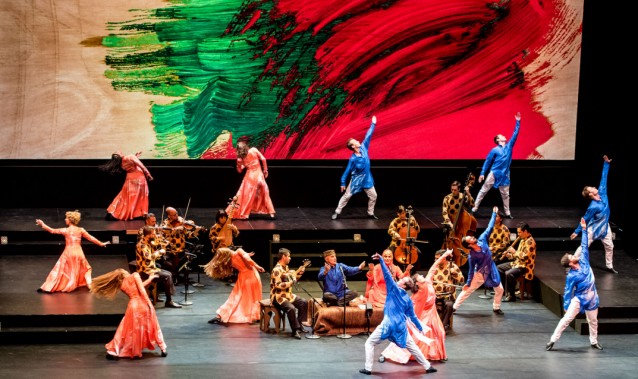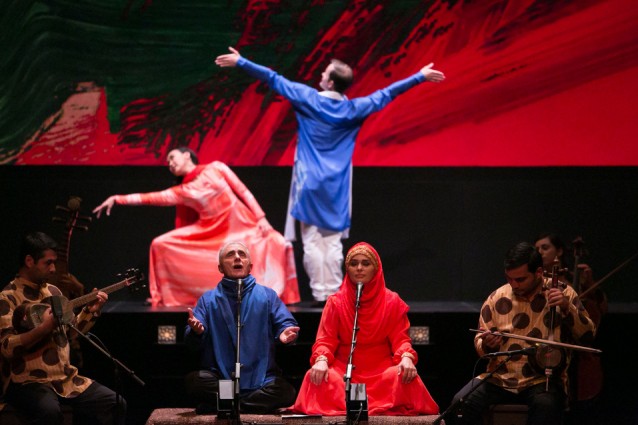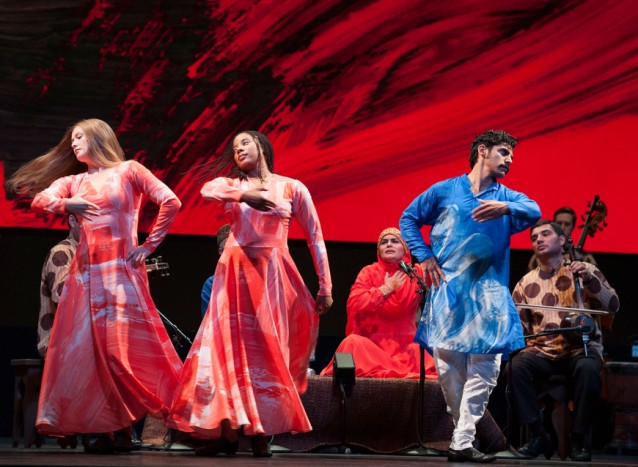There are few stories in world literature as enduring as Layla and Majnun. Versions of the Arabic legend, which is known as the Romeo and Juliet of the East (although it pre-dates Shakespeare by at least a millennium!) were developed orally in countries across Central Asia, India and the Middle East. Over the years, the story has been slowly working its way west. In the fall of 2017 it arrived in the Lincoln Center in New York City as a full-scale production (which had made its official world premiere in California in September 2016). The journey made by Layla and Majnun from an ancient Eastern oral tradition to an edgy New York stage production has been an epic in itself. The main characters who have brought the story to life span centuries, but they bear this in common: they have been forward-thinking cultural interpreters.
One such mediator of cross-cultural understanding is Dr Aida Huseynova of Indiana University Jacobs School of Music, the research advisor for the Silk Road Ensemble and Mark Morris Dance Group. She explains the appeal of the new version of the epic: One reason this arrangement is very special is that it now has the input of the true luminaries of music and culture from all over the globe. The poetry of Fuzuli, the music by Hajibeyli, and unique musicianship and artistry of Alim Qasimov, Yo-Yo Ma and Mark Morris – this list is quite telling, not to mention the expressive stage design by Howard Hodgkin and contributions of every member of the team of musicians, artists, and many people behind the scenes!
 Performance of Layla and Majnun. Photo: Susana Millman, provided courtesy of Mark Morris Dance Group
Performance of Layla and Majnun. Photo: Susana Millman, provided courtesy of Mark Morris Dance Group
The production website offers this summary of the legend:
Layla and Qays are in love from childhood but are not allowed to unite. Qays (called Majnun, which means “possessed”) is perceived to be mad in his obsession with Layla. Layla is married off to another and Majnun becomes a hermit, devoting himself to writing verses about his profound love of Layla. Although they attempt to meet, they die without ever realizing a relationship.
The tale entered Azerbaijani history in the 12th century when Nizami Ganjavi (1141-1209) wrote a version of it in Persian language. Then it was canonized into Azerbaijani literature after the 16th century when the trilingual philosopher Muhammad bin Suleyman (c.1494–1556), using the pen name Fuzuli, wrote his own poetic version of it in his native Azerbaijani language. Later in 1908, composer Uzeyir Hajibeyli (1885–1948) penned an opera with its libretto based on this version. (Hajibeyli’s libretto is the version that Huseynova and Isabelle Hunter translated into English for the Lincoln Center production’s programme notes.)
 Alim Qasimov and Fargana Qasimova sing from centre stage. Photo: Susana Millman, provided courtesy of Mark Morris Dance Group
Alim Qasimov and Fargana Qasimova sing from centre stage. Photo: Susana Millman, provided courtesy of Mark Morris Dance Group
Hajibeyli was on the cutting edge of his era, ever searching for ways to bring Azerbaijani music and the classical Western scene together. He founded the Azerbaijani State Choir and the Azerbaijani Folk Instruments Orchestra, writing arrangements of Western classics for national instruments. Hajibeyli is known as the first composer of Western-style opera in the Islamic world, but his calling card was to use national music in his work. So he composed his version of Layla and Majnun in the style of mugham, a complex system of musical improvisation characteristic to Azerbaijan and the Eastern world. The score called for both national and Western instruments.
Thus from its inception as an opera at the hand of Hajibeyli, Layla and Majnun was destined to take Eastern flavour to the Western stage. This version of Layla and Majnun premiered in 1908, soon became popular in Azerbaijan and graced the stage of the Azerbaijan State Opera and Ballet Theatre year after year (Wikipedia claims that it has now been performed there over 20,000 times). The lead role of Qays was often played by Alim Qasimov, a modern star of the Azerbaijani mugham world. As a highly acclaimed vocalist and cultural ambassador, Qasimov facilitated the next stage in the evolution of Layla and Majnun in 2006 when he pitched the idea of a new interpretation of the work to the Silk Road Ensemble, a non-profit collaborative group dedicated to Eurasian music that was established by the famously versatile cellist Yo-Yo Ma.
Together Qasimov and Ma prepared the work for the Western stage. In 2016 they re-envisioned the epic with a twist: like Hajibeyli’s version, the performance called for both Azerbaijani and Western instruments, but this time it was retooled as a brand-new dance fusion. According to The New York Times, the epic was interpreted into movement as “a danced opera” by influential choreographer Mark Morris, who incorporated some Azerbaijani elements into the dance but created a new synthesis accessible to modern New York audiences. As Huseynova explains, Layla and Majnun is a quintessential expression of Azerbaijani musical nationalism and, in the meantime, it has rich multicultural potential. The new arrangements created by the Silk Road Ensemble and Mark Morris Dance Group have decoded many of those multicultural messages and delivered them to audiences thousands of miles away from the place where this work was created.
 Dancers take turns performing the roles of the main characters through the evening. Photo: Susana Millman, provided courtesy of Mark Morris Dance Group
Dancers take turns performing the roles of the main characters through the evening. Photo: Susana Millman, provided courtesy of Mark Morris Dance Group
The performance was designed to be 70 minutes long. Alim Qasimov and his daughter Fargana Qasimova, also a renowned mugham singer, sat on pillows on a slightly raised platform at the centre of the stage, in the style of historic divan poetry performances, flanked by the musical ensemble. 16 dancers swirled around them in Azerbaijani-inspired costumes, taking turns representing the lead characters through various stages in their story. But this production brought unique challenges to the dance team:
The entire production is built upon the idea of unexpectedness, Huseynova says. Layla and Majnun is a mugham opera, and mugham is a genre of music based on improvisation. Alim and Fargana Qasimov never repeat themselves as they perform mugham, and for this reason, the balance between music and dance is unique at each show and each rehearsal. This is the amazing beauty of this production.
If you missed the show at the Lincoln Center this fall, never fear: further performances are planned for March 2018 in Illinois and Washington, D.C. (see the details at www.Laylaandmajnun.org/performance-calendar/).


.jpg)